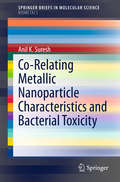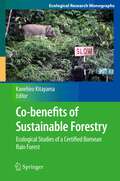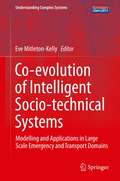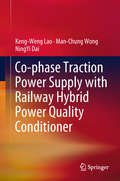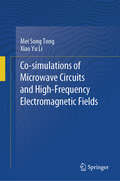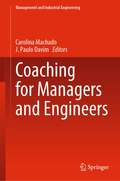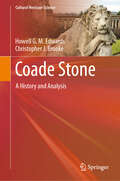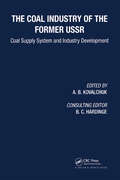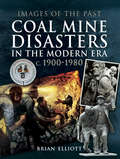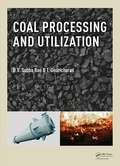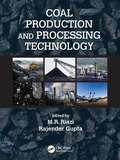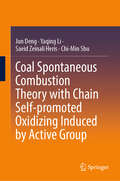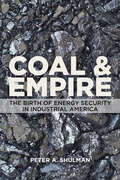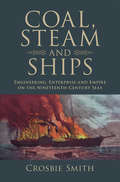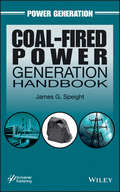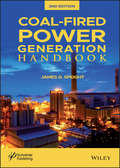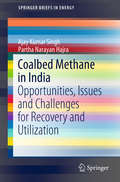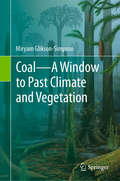- Table View
- List View
Co-Relating Metallic Nanoparticle Characteristics and Bacterial Toxicity (SpringerBriefs in Molecular Science)
by Anil K. SureshThis brief gives a concise overview of nanoparticles and their microbial toxicity. It introduces various nanoparticles that are considered lethal to microbial cells (bacteria, virus and fungus) placing an emphasis on metal and metal oxide nanoparticles. The synthesis procedures (physical, chemical, microbial) that are often employed in their fabrication are also outlined. The interaction of various nanoparticles with microbes is described with attention given to the role of additives in the form of solvents, surfactants, capping materials. Commonly used experimental and analytical techniques that are often used to evaluate and determine the toxicity of nanoparticles towards different microorganisms are presented and comparative assessments on the differences between these procedures are described. The brief ends by explaining the toxicity of metal and metal oxide nanoparticles to microorganisms.
Co-benefits of Sustainable Forestry: Ecological Studies of a Certified Bornean Rain Forest (Ecological Research Monographs)
by Kanehiro KitayamaTropical rain forests are increasingly expected to serve for climate change mitigation and biodiversity conservation amid global climate change and increasing human demands for land. Natural production forests that are legally designated to produce timber occur widely in the Southeast Asian tropics. Synergizing timber production, climate change mitigation and biodiversity conservation in such tropical production forests is one of the most realistic means to resolve these contemporary global problems. Next-generation sustainable forest management is being practiced in the natural tropical rain forest of a model site in Sabah, Malaysian Borneo, while earlier sustainable management practices have generally failed, leading to extensive deforestation and forest degradation elsewhere in the tropics. Ecologists have examined co-benefits of sustainable forestry in the model forest in terms of forest regeneration, carbon sequestration and biodiversity in comparison to a forest managed by destructive conventional methods. Taxonomic groups studied have included trees, decomposers, soil microbes, insects and mammals. A wide array of field methods and technology has been used including count plots, sensor cameras, and satellite remote-sensing. This book is a compilation of the results of those thorough ecological investigations and elucidates ecological processes of tropical rain forests after logging. The book furnishes useful information for foresters and conservation NGOs, and it also provides baseline information for biologists and ecologists. A further aim is to examine the environmental effects of a forest certification scheme as the model forest has been certified by the Forest Stewardship Council. Taken as a whole, this book proves that the desired synergy is possible.
Co-evolution of Intelligent Socio-technical Systems: Modelling and Applications in Large Scale Emergency and Transport Domains (Understanding Complex Systems)
by Evangelia Mitleton-KellyAs the interconnectivity between humans through technical devices is becoming ubiquitous, the next step is already in the making: ambient intelligence, i.e. smart (technical) environments, which will eventually play the same active role in communication as the human players, leading to a co-evolution in all domains where real-time communication is essential. This topical volume, based on the findings of the Socionical European research project, gives equal attention to two highly relevant domains of applications: transport, specifically traffic, dynamics from the viewpoint of a socio-technical interaction and evacuation scenarios for large-scale emergency situations. Care was taken to investigate as much as possible the limits of scalability and to combine the modeling using complex systems science approaches with relevant data analysis.
Co-phase Traction Power Supply with Railway Hybrid Power Quality Conditioner
by Man-Chung Wong Keng-Weng Lao NingYi DaiThis book offers a brief review of and investigations into the power quality problem in the new technology of co-phase high-speed traction power supplies, which benefits for higher locomotive speed. In addition, it presents detailed design procedures and discusses the chief concerns in connection with a newly proposed solution: compensation in co-phase traction power using a co-phase railway hybrid power quality conditioner (Railway HPQC). Further, it provides essential information on the modeling of power quality in co-phase, high-speed traction power supplies, and on power quality compensation algorithm derivations. Lastly, it delineates the design of railway HPQC and analyzes the effect of different parameters on its performance to accommodate different priorities. All design is supported by simulations and the results of experimental verification.
Co-simulations of Microwave Circuits and High-Frequency Electromagnetic Fields
by Mei Song Tong Xiao Yu LiThis book aims to provide many advanced application topics for microwave circuits and high-frequency electromagnetic (EM) fields by using advanced design system (ADS) and high-frequency structure simulator (HFSS) as simulation platforms. In particular, it contains the latest multidisciplinary co-simulation guidance on the design of relevant components and devices. Currently, the circuit/field design and performance analysis and optimization strongly rely on various kinds of robust electronic design automation (EDA) software. RF/microwave engineers must grasp two or more types of related simulation design software. ADS by Keysight and HFSS by Ansys are the representative for circuit simulations and for field and structural simulations of microwave devices, respectively. At present, these two types of software are widely used in enterprises, universities, and research institutions. The main purpose of this book is to enable readers, who are interested in microwave engineering and applied electromagnetics, to master the applications of these two tools. It also helps readers expand their knowledge boundaries behind those types of software and deepen their understanding of developing interdisciplinary technologies by co-simulations. The book is divided into three parts. The first part introduces the two latest versions of ADS and HFSS and helps readers better understand the basic principles and latest functions better. It also advises how to choose appropriate simulation tools for different problems. The second part mainly describes co-simulations for high-frequency EM fields, microwave circuits, antenna designs, EM compatibility (EMC), and thermal and structural analyses. It provides guides and advices on performing co-simulations by ADS and HFSS incorporated with other types of software, respectively. The last part narrates the automation interfaces and script programming methods for co-simulations. It primarily deals with the Advanced Extension Language (AEL), Python Data Link (PDL), and MATLAB interface in ADS. For HFSS, it discusses VBScript, IronPython scripting, and Application Programming Interface (APIs) based on MATLAB. Each topic contains practical examples to help readers understand so that they can gain a solid knowledge and skills regarding automated interfaces and scripting methods based on these kinds of software. Concisely written in combination with practical examples, this book is very suitable as a textbook in introductory courses on microwave circuit and EM simulations and also as a supplementary textbook in many courses on electronics, microwave engineering, communication engineering, and related fields. As well, it can serve as a reference book for microwave engineers and researchers.
Coabsorbent and Thermal Recovery Compression Heat Pumping Technologies (Heat and Mass Transfer)
by Mihail-Dan StaicoviciThis book introduces two of the most exciting heat pumping technologies, the coabsorbent and the thermal recovery (mechanical vapor) compression, characterized by a high potential in primary energy savings and environmental protection. New cycles with potential applications of nontruncated, truncated, hybrid truncated, and multi-effect coabsorbent types are introduced in this work Thermal-to-work recovery compression (TWRC) is the first of two particular methods explored here, including how superheat is converted into work, which diminishes the compressor work input. In the second method, thermal-to-thermal recovery compression (TTRC), the superheat is converted into useful cooling and/or heating, and added to the cycle output effect via the coabsorbent technology. These and other methods of discharge gas superheat recovery are analyzed for single-, two-, three-, and multi-stage compression cooling and heating, ammonia and ammonia-water cycles, and the effectiveness results are given. The author presents absorption-related topics, including the divided-device method for mass and heat transfer analysis, and truncation as a unique method for a better source-task match. Along with advanced gax recovery, the first and second principles of COP and exergy calculation, the ideal point approaching (i. p. a. ) effect and the two-point theory of mass and heat transfer, the book also addresses the new wording of the Laplace equation, the Marangoni effect true explanation, and the new mass and heat exchangers based on this effect The work goes on to explore coabsorbent separate and combined cooling, heating, and power (CHP) production and advanced water-lithium bromide cycle air-conditioning, as well as analyzing high-efficiency ammonia-water heat-driven heating and industrial low-temperature cooling, in detail Readers will learn how coabsorbent technology is based on classic absorption, but is more general. It is capable of offering effective solutions for all cooling and heating applications (industry, agriculture, district, household, etc. ), provided that two supplying heat-sink sources with temperatures outdistanced by a minimum of 12-15ºC are available This book has clear and concise presentation and illustrates the theory and applications with diagrams, tables, and flowcharts.
Coach in Progress: Marshall Football?A Story of Survival and Revival
by Bobby Bowden Patrick Garbin Red Dawson Fred BiletnikoffA Coach in Progress depicts the catastrophe of the Southern Airways flight that crashed en route to Huntington, West Virginia, in 1970, killing all seventy-five passengers on board: players, coaches, and boosters of the Marshall University football team, as well as the flight crew. From this tragedy, the foundation of the Marshall football program was laid, and it has thrived ever since, culminating with the Thundering Herd being the winningest team in the NCAA Division I program in the 1990s, portrayed in the hit movie We Are Marshall, and currently under the direction of head coach Doc Holliday. This book is written from the viewpoint of Red Dawson, a former Marshall assistant football coach, who was one of the few team members not on the plane. Still suffering from survivor’s guilt decades after the crash, Red has recovered enough to finally discuss the disaster in full. What’s more, Red helped build a team with mostly freshmen and walk-ons in 1971, and thus was recognized as bridging "the gap from tragedy to rebirth” of the Marshall football program. Red also reveals what he previously would not discuss: the seemingly insurmountable obstacles he faced prior to the plane crash and the difficulties that followed the tragedy, like the heated tension that persisted between school administrators and a harassed and confused Red as they all attempted to rebuild the devastated program. This book is the story of Red Dawson’s involvement with Marshall football during the last near half century spent living with the memories of the worst sports-related air tragedy in history.
Coaching for Managers and Engineers (Management and Industrial Engineering)
by J. Paulo Davim Carolina MachadoThis book communicates the latest developments and thinking on the coaching subject worldwide. It presents insights into coaching in the management and engineering field on an international and transnational scale. The chapters contain innovative models, processes, strategies and uses, as well as the most recent research activities relating to coaching. This book highlights key issues and uses related to coaching for managers and engineers.
Coade Stone: A History and Analysis (Cultural Heritage Science)
by Howell G. Edwards Christopher J. BrookeThe history and nature of artificial stone for use in architecture is a subject still shrouded in myth and misconception. This book aims to lay bare those misconceptions and present a scientific and architectural account of these materials, and especially Coade Stone, the most successful of all, which found great favour during the Georgian period. Many examples of Coade Stone cast sculpture still exist and several key examples are presented in context and as case studies . Eleanor Coade’s artificial stone was so good that many observers could not distinguish it from the natural stone it replaced: the growth in replication of the neo-classical statuary and building adornment required in the late Georgian and Regency period was well satisfied by the use of Coade stone. A holistic evaluation of Coade stone artefacts is undertaken whereby the use of analytical data, historical documentation, invoices, company records, impressed marks and expert connoisseurship will establishthe attribution of Coade stone artefacts, some of which are currently in the unknown category. Several new scientific analyses are presented that demonstrate the true nature of high temperature fired ceramic Coade Stone and allow comparison with other forms of artificial stone, such as the cold cured cementitious variations, which eventually replaced it in the Victorian period.
Coal Industry of the Former USSR: Coal Supply System and Industry Development
by A. B. Kovalchuk B. C. HardingeThe Coal Industry of the Former USSR presents a two-part study of coal supply systems and development of the industry in the territory of the former USSR. The first part covers the role of coal in the economy, provides an overview of current status and forecast of the eight major coal basins and environmental problems associated with the industry.
Coal Mechanics
by Yuanping Cheng Qingquan Liu Ting RenThis book focuses on the mechanical properties and permeability of coal, and the gas flow in coal seams. Based on coal permeability models, it establishes different models for coal seam gas, from the linear flow model to the gas–solid coupling flow model. It also provides the theoretical basis for the exploitation and safe production of coal as well as coal seam gas resources. As such, it is a valuable reference for researchers, advanced students and practitioners working in mining engineering and coalbed methane engineering.
Coal Mine Disasters in the Modern Era c. 1900–1980 (Images of the Past)
by Brian Elliott&“These haunting images, with well-researched facts, figures and timelines providing context, bring the bygone era of 20th-century coal mining to life.&”—Family Tree Although everyday fatalities in mines was far greater, it was the disasters that encouraged those in power to reform the way in which miners had to work underground, especially with regard to safety. And it would be no exaggeration to say that it was the disasters that greatly contributed to bringing the coal industry into national control. Sadly, for bereaved individuals and families, nothing could really compensate for the loss of one or more of a loved one. The impact of the big disasters, where hundreds of men and boys—one or two generations—were lost, immediately, the impact was massive, and continued to be felt many years afterwards. New and restored disaster memorials bear testimony to the great respect that former mining communities continue to have for their &“lost miners.&” Using many previously unpublished images, and a carefully supportive text, the author provides a detailed overview of mining disasters in the modern era, from the early 1900s to the 1980s. It is the first book of its kind to attempt such a large project in pictorial form with a foreword by Ceri Thompson, curator of the Big Pit, the Welsh national mining museum. The book is published at a particularly poignant time, after the recent closure of Britain&’s last deep coal mine. &“So many remarkable photographs and drawings: The story may be tragic, but it is one that lies at the very heart of the history of coal mining in Britain.&”—WDYTYA? magazine
Coal Processing and Utilization
by D.V. Subba Rao T. GouricharanThis book is a direct outgrowth of classes that the authors gave over a period of three decades to a university audience taking a Mineral Beneficiation course as a major that included coal processing and utilization. It is designed to be used as a student's (or layman's) first introduction to coal processing and utilization, motivating the concepts
Coal Production and Processing Technology (Fuels and Petrochemicals)
by M. R. Riazi Rajender GuptaCoal Production and Processing Technology provides uniquely comprehensive coverage of the latest coal technologies used in everything from mining to greenhouse gas mitigation. Featuring contributions from experts in industry and academia, this book:Discusses coal geology, characterization, beneficiation, combustion, coking, gasification, and liquef
Coal Spontaneous Combustion Theory with Chain Self-promoted Oxidizing Induced by Active Group
by Jun Deng Chi-Min Shu Yaqing Li Saeid Zeinali HerisThis book provides a scientific basis for development of targeted inhibitors and directional inhibitors of preventing spontaneous combustion of coal. This book applied solvent extraction assisted by ultrasonic into the study of coal spontaneous combustion and hence broken through the technical bottlenecks of existing studies for mechanisms of coal spontaneous combustion. Further, the theories of particles physics were firstly combined with theories of coal chemistry and finally explained some previous conjectures scientifically in this book. Thus, the theory of spontaneous combustion of coal has been greatly broadened and deepened. Moreover, a new theory named &“Chain self-promoted oxidizing coal spontaneous combustion theory induced by active group&” was proposed in this book. This theory elucidates the correlation mechanism between coal active groups and indicator gases, explaining the mechanism of indicator gas generation in coal spontaneous combustion and providing a theoretical basis for establishing an early warning indicator system for coal spontaneous combustion. This is very easy to be understood by audience with working in the field of mining or coal chemistry. Besides, principles of theories used in this book were explained in detail in this book. That is to say, there are almost no challenges or pain points for the audiences to overcome.
Coal and Biomass Gasification: Recent Advances and Future Challenges (Energy, Environment, and Sustainability)
by Avinash Kumar Agarwal Santanu De V. S. Moholkar Bhaskar ThalladaThis book addresses the science and technology of the gasification process and the production of electricity, synthetic fuels and other useful chemicals. Pursuing a holistic approach, it covers the fundamentals of gasification and its various applications. In addition to discussing recent advances and outlining future directions, it covers advanced topics such as underground coal gasification and chemical looping combustion, and describes the state-of-the-art experimental techniques, modeling and numerical simulations, environmentally friendly approaches, and technological challenges involved. Written in an easy-to-understand format with a comprehensive glossary and bibliography, the book offers an ideal reference guide to coal and biomass gasification for beginners, engineers and researchers involved in designing or operating gasification plants.
Coal and Empire: The Birth of Energy Security in Industrial America
by Peter A. ShulmanThe fascinating history of how coal-based energy became entangled with American security.Since the early twentieth century, Americans have associated oil with national security. From World War I to American involvement in the Middle East, this connection has seemed a self-evident truth. But, as Peter A. Shulman argues, Americans had to learn to think about the geopolitics of energy in terms of security, and they did so beginning in the nineteenth century: the age of coal. Coal and Empire insightfully weaves together pivotal moments in the history of science and technology by linking coal and steam to the realms of foreign relations, navy logistics, and American politics. Long before oil, coal allowed Americans to rethink the place of the United States in the world.Shulman explores how the development of coal-fired oceangoing steam power in the 1840s created new questions, opportunities, and problems for U.S. foreign relations and naval strategy. The search for coal, for example, helped take Commodore Matthew Perry to Japan in the 1850s. It facilitated Abraham Lincoln's pursuit of black colonization in 1860s Panama. After the Civil War, it led Americans to debate whether a need for coaling stations required the construction of a global empire. Until 1898, however, Americans preferred to answer the questions posed by coal with new technologies rather than new territories. Afterward, the establishment of America's string of island outposts created an entirely different demand for coal to secure the country's new colonial borders, a process that paved the way for how Americans incorporated oil into their strategic thought. By exploring how the security dimensions of energy were not intrinsically linked to a particular source of power but rather to political choices about America's role in the world, Shulman ultimately suggests that contemporary global struggles over energy will never disappear, even if oil is someday displaced by alternative sources of power.
Coal in Campbell County (Images of America)
by Mary Kelley Campbell County Rockpile MuseumIn his Annual Report of the Territorial Geologist to the Governor of Wyoming 1890, Louis D. Ricketts wrote, "The coal of this district has little other use than that of supplying a local market." Years later, nothing could be further from the truth. The United States uses approximately one billion tons of coal a year, with about 390 million tons coming from Campbell County, Wyoming. Since large-scale commercial coal production began in Campbell County in the mid-1970s, most coal companies have changed names, owners, and boundaries several times. To let those changes go unrecorded would be to lose the very beginning of coal in Campbell County.
Coal, Steam and Ships: Engineering, Enterprise and Empire on the Nineteenth-Century Seas (Science in History)
by Crosbie SmithCrosbie Smith explores the trials and tribulations of first-generation Victorian mail steamship lines, their passengers, proprietors and the public. Eyewitness accounts show in rich detail how these enterprises engineered their ships, constructed empire-wide systems of steam navigation and won or lost public confidence in the process. Controlling recalcitrant elements within and around steamship systems, however, presented constant challenges to company managers as they attempted to build trust and confidence. Managers thus wrestled to control shipbuilding and marine engine-making, coal consumption, quality and supply, shipboard discipline, religious readings, relations with the Admiralty and government, anxious proprietors, and the media - especially following a disaster or accident. Emphasizing interconnections between maritime history, the history of engineering and Victorian culture, Smith's innovative history of early ocean steamships reveals the fraught uncertainties of Victorian life on the seas.
Coal-Fired Power Generation Handbook
by James G. SpeightThe most complete and up-to-date handbook on power generation from coal, this book covers all of today's new, cleaner methods for creating electricity from coal, the environmental challenges and concerns involved in its production, and developing technologies. It describes new technologies that could virtually eliminate the sulfur, nitrogen, and mercury pollutants released when coal is burned for electricity generation. In addition, the text details technologies for greenhouse gases capture from coal-fired power plants, as well as for preventing such emissions from contributing to global warming.
Coal-Fired Power Generation Handbook (Power Generation)
by James G. SpeightCoal accounts for approximately one quarter of world energy consumption and of the coal produced worldwide approximately 65% is shipped to electricity producers and 33% to industrial consumers, with most of the remainder going to consumers in the residential and commercial sectors. The total share of total world energy consumption by coal is expected to increase to almost 30% in 2035. This book describes the challenges and steps by which electricity is produced form coal and deals with the challenges for removing the environmental objections to the use of coal in future power plants. New technologies are described that could virtually eliminate the sulfur, nitrogen, and mercury pollutants that are released when coal is burned for electricity generation. In addition, technologies for the capture greenhouse gases emitted from coal-fired power plants are described and the means of preventing such emissions from contributing to global warming concerns. Written by one of the world’s leading energy experts, this volume is a must-have for any engineer, scientist, or student working in this field, providing a valuable reference and guide in a quickly changing field.
Coal: Energy for the Future
by Committee on the Strategic Assessment of the U.S. Department of Energy's Coal ProgramThe U.S. Department of Energy (DOE) was given a mandate in the 1992 Energy Policy Act (EPACT) to pursue strategies in coal technology that promote a more competitive economy, a cleaner environment, and increased energy security.Coal evaluates DOE's performance and recommends priorities in updating its coal program and responding to EPACT.This volume provides a picture of likely future coal use and associated technology requirements through the year 2040. Based on near-, mid-, and long-term scenarios, the committee presents a framework for DOE to use in identifying R&D strategies and in making detailed assessments of specific programs.Coal offers an overview of coal-related programs and recent budget trends and explores principal issues in future U.S. and foreign coal use.The volume evaluates DOE Fossil Energy R&D programs in such key areas as electric power generation and conversion of coal to clean fuels.Coal will be important to energy policymakers, executives in the power industry and related trade associations, environmental organizations, and researchers.
Coalbed Methane in China: Geological Theory and Development
by Yan Song Xinmin Zhang Shaobo LiuThe coalbed methane (CBM) reserve in China ranks third in the world with a total resource of 36.8×1012 m3. Exploitation of CBM has an important practical significance to ensure the long-term rapid development of China natural gas industry. Therefore, in 2002, the Ministry of Science and Technology of China set up a national 973 program to study CBM system and resolve problems of CBM exploration and exploitation in China. All the main research results and new insights from the program are presented in this book. The book is divided into 11 chapters. The first chapter mainly introduces the present situation of CBM exploration and development in China and abroad. Chapters 2 through 9 illustrate the geological theory and prospect evaluation methods. Then chapters 10 and 11 discuss CBM recovery mechanisms and technology. The book systematically describes the origin, storage, accumulation and emission of CBM in China, and also proposes new methods and technologies on resource evaluation, prospect prediction, seismic interpretation and enhanced recovery. The book will appeal to geologists, lecturers and students who are involved in the CBM industry and connected with coal and conventional hydrocarbon resources research.
Coalbed Methane in India: Opportunities, Issues and Challenges for Recovery and Utilization (SpringerBriefs in Energy)
by Ajay Kumar Singh Partha Narayan HajraThis book offers a first-of-its-kind, standalone review of coalbed methane (CBM) in India, covering all the major technical and policy aspects. As an authoritative text on CBM in India, it addresses the essential geological, engineering and policy issues. The Coalbed Methane industry is a rapidly developing sector in Indian energy supply. The book presents the characteristics of coal beds in India's Damodar and Son river valleys, which influence the commercial viability of CBM in the regions, as well as a study of the gas contents of the country's major coalfields. The book begins with a brief review of methane emissions from Indian coal mines and the current coalbed methane situation in the country. Its unique features include a coalfield-by-coalfield technical assessment of CBM throughout India. Policy matters are addressed, including the National Exploration Licencing Policy (NELP) of the Indian Government Ministry of Petroleum and Natural Gas, which is vital to an overall understanding of CBM development in the country. The scope and depth of its book's coverage will benefit students, practising engineers, researchers and policy-makers.
Coal—A Window to Past Climate and Vegetation
by Miryam Glikson-SimpsonThis book focuses on the Permian time slice in the geological history of Gondwana, which includes Australia, India, South Africa, Antarctica and South America. Coal is an organic rock, the product of compressed and ‘cooked’ plants. The exact formation of coal via physicochemical reactions, burial and subsidence is the subject of numerous books. The vast thick coal deposits characterising Gondwana formed from special kind of trees termed the Glossopteris Flora. These trees shed their leaves in winter and with the rest of their remains decayed and through subsidence and burial formed the coal. Pollen preserved from these plant communities has been concentrated and isolated and is the focus of this book. The first plant communities as can be seen from the pollen graphs in this book were impoverished in species. The Permian era started with a very cold climate and as the climate warmed more and more diverse vegetation took hold. The emergence of different forms of pollen at certain times in the Permian is used as an indicator of climatic change. Furthermore, the predominance of algal spores in some samples and lack of representation by pollen of Glossopteris point to significant changes in the climate which led to the disappearance of their pollen and the accumulation of spores representing algal communities. These climate induced changes are noticed in their completed transformation after a long time span; small changes are evident during a lifetime of Earth’s inhabitants. Today, in our lifetime, we can see and witness the drying of many lakes across the Earth and their total disappearance from maps of only 50 years ago is a testimony to a climatic change taking place. The time of a ‘complete’ change in the Permian is possible to calculate. However, to determine the duration and maximum change in the climate of the earth today is impossible due to the apparent acceleration of the process by industrial activities of our species. Chapter 4 in the book deals with the special characteristics of the Permian coals of Gondwana and the special plant community which made them. The composition of these coals on a microscopic level shows them to be rich in hydrocarbons, more than other coals. The Permian coals of India and Australia generate ‘heavy’ oil which is retained within the coal matrix as bitumen and is a potential source of methane. This chapter demonstrates through a pilot study the potential for explosion in the Permian Gondwana coals through their propensity to spontaneous combustion and methane generation.
